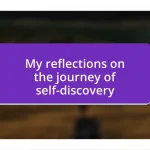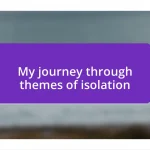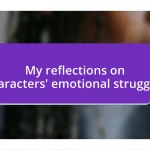Key takeaways:
- Dynamic character scenes are essential for reflecting internal conflicts and pivotal moments, enhancing relatability through emotional authenticity and environmental cues.
- Dialogue should reveal character depth and maintain authenticity, utilizing natural language and tension to create engaging conversations that resonate with readers.
- Revising interactions, focusing on body language and character motivations, can transform scenes, making them more emotionally impactful and relatable.

Understanding dynamic character scenes
Dynamic character scenes are where transformation occurs, and these shifts in a character often reflect pivotal moments in their journey. I remember crafting a scene where my protagonist faced a critical choice, and the emotional weight of that decision changed everything for her. It made me wonder: how often do we find ourselves at such crossroads in our own lives, and how does that shape who we become?
In creating these scenes, I learned that it’s essential to explore the character’s internal conflicts. For instance, a moment when my character had to confront her fears became profound for me. As she hesitated to leap into the unknown, I felt her anxiety echoing my own moments of uncertainty. It’s incredible how these nuanced feelings can create depth and authenticity in character development.
Moreover, the environment surrounding these scenes plays a vital role in conveying a character’s inner dynamic. I recall writing a dramatic confrontation set against a stormy backdrop that mirrored my character’s turmoil. It really struck me how setting can amplify emotions, prompting readers to connect with characters on a deeper level. Have you ever noticed how the surroundings can enhance a character’s experience? It truly enriches the storytelling.

Identifying core character traits
Identifying core character traits begins with a thorough understanding of who your character truly is at their essence. For me, this often involves short exercises, like journaling as the character or even imagining coffee conversations with them. These moments uncover their beliefs, motivations, and fears, revealing layers that can shape their decisions and interactions. During one project, I grabbed a cup of tea and poured out thoughts as if I were my character, and suddenly, traits I hadn’t even considered bubbled to the surface.
To help identify these core traits, I focus on specific aspects that define a character. Here’s a helpful list I’ve developed over time:
- Values: What principles guide their decisions?
- Motivations: What drives them to act or not act?
- Conflicts: What internal or external struggles impact their development?
- Strengths/Weaknesses: What are they good at, and where do they falter?
- Emotional responses: How do they react under stress or joy?
- Backstory: How do their past experiences inform their current behavior?
By reflecting on these elements, I find that my characters become more tangible, evolving from mere concepts into beings with whom I, and hopefully my readers, can connect.
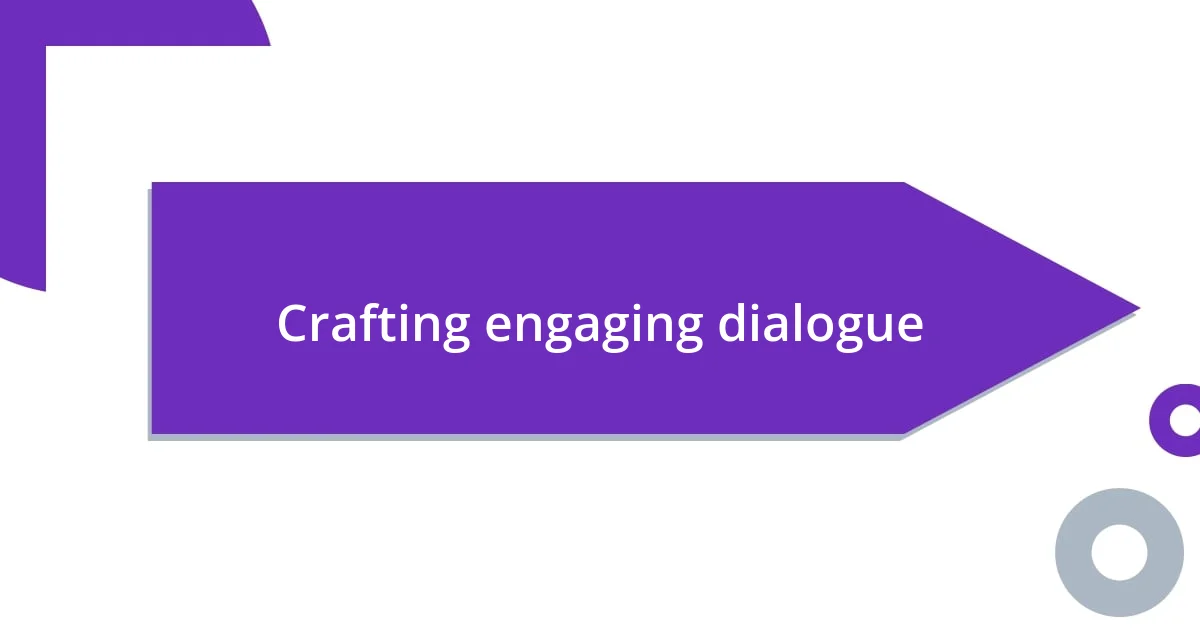
Crafting engaging dialogue
Crafting engaging dialogue requires an understanding of your characters and their unique voices. I often think about how my characters sound to each other; it’s like eavesdropping on a fascinating conversation. For example, in one scene I wrote, a witty exchange between two friends included a mix of playful banter and underlying tension. It struck me that the rhythm and cadence of their speech not only revealed their relationship dynamics but also made the dialogue feel alive and relatable.
I’ve noticed that dialogue can serve double duty—advancing the plot while revealing character depth. During a pivotal moment in my story, a character’s terse, clipped responses made it clear they were hiding vulnerability beneath their bravado. This juxtaposition of what is said and what is left unsaid can create real tension, and I’ve found that readers often connect with these layers. What about you? Have you ever felt that a character’s dialogue resonated with your own experiences?
To make dialogue engaging, I always remember to incorporate natural language, avoiding overly formal speech. Reflecting on a conversation I had with a friend about an extremely awkward date made me realize how we often stumble over words, laugh at ourselves, or use colloquialisms that are characteristic of our backgrounds. This authenticity in dialogue can significantly enhance a reader’s connection to the characters, allowing them to see parts of themselves within the narrative.
| Aspect of Dialogue | Description |
|---|---|
| Voice | Unique way characters express themselves |
| Tension | Conflict conveyed through what is said and unsaid |
| Authenticity | Natural language that reflects real conversations |
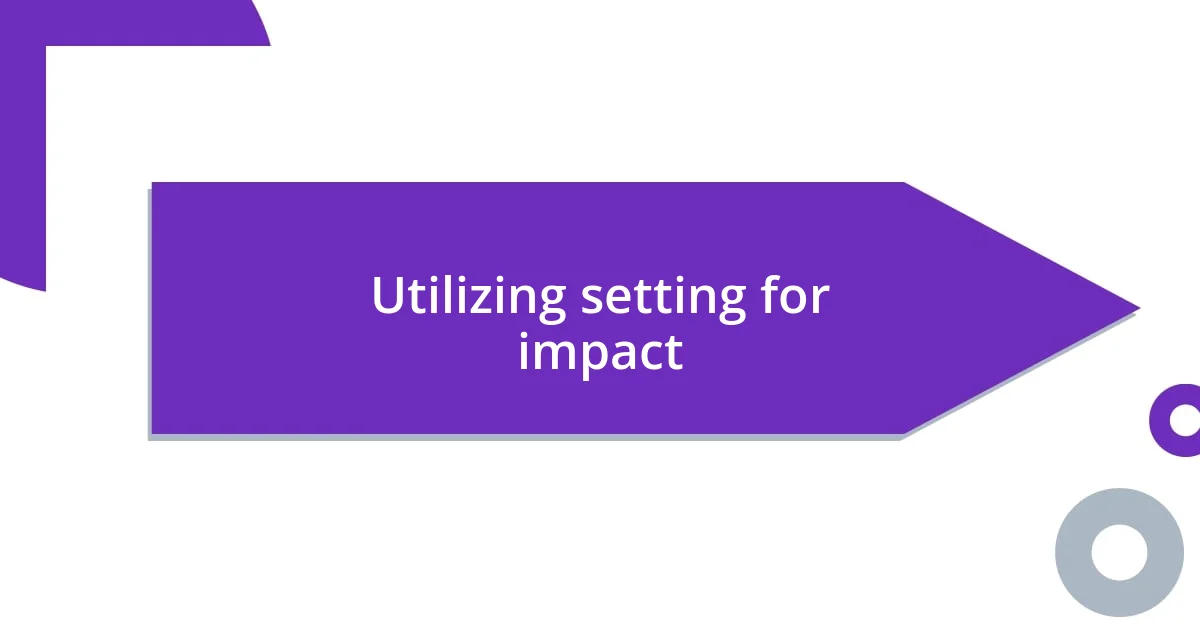
Utilizing setting for impact
When I think about utilizing setting for impact, I remember a scene I crafted in a dilapidated old house. The peeling wallpaper and creaking floorboards weren’t just backdrops; they mirrored the fractured relationship of my characters. As they explored the house, the setting’s decay underscored their emotional disconnection, making the atmosphere feel thick with unresolved tension. Doesn’t it strike you how much a well-crafted setting can enhance a scene?
In another project, I set a pivotal confrontation during a thunderstorm. The foreboding weather echoed my characters’ inner turmoil and heightened their emotions. It’s fascinating how the crack of thunder punctuated their heated dialogue, amplifying every word and glance. I often wonder how my readers perceive these choices—do they feel the storm’s electricity in their own chests as I do?
Utilizing setting effectively also involves clever placement of small details that evoke memory and mood. Picture a character standing at the edge of a serene lake, reflecting on past mistakes as the sun sets. This peaceful imagery contrasts starkly with their inner dialogue, drawing the reader deeper into their psyche. I’ve learned that these seemingly minor elements can profoundly impact how readers connect with the characters’ journeys. Have you ever experienced a scene where the setting just felt alive, pulling you right into the character’s emotional world?

Showcasing character development techniques
Character development techniques can take many forms, and one of my favorites is showcasing internal conflict. I once wrote a scene where a character grapples with guilt as she prepares for a long-awaited celebration. The struggle between her desire to enjoy the moment and the weight of her past mistakes created a poignant tension that resonated with me. I find that exploring these internal battles allows readers to connect deeply with the emotional layers of a character’s journey. Have you ever felt a character’s internal struggle mirroring your own moments of doubt?
Another technique I’ve found effective is revealing character traits through action. For instance, I created a scene where a character impulsively helps a stranger in distress. This act of kindness wasn’t just a plot point; it revealed her compassionate nature and set the stage for her growth throughout the story. Observing how characters react under pressure can reveal much about who they truly are, don’t you think? It’s like peeling back layers of an onion, revealing the essence of the character with each choice they make.
Lastly, using flashbacks can be a powerful tool to showcase character development. I’ve had moments where a brief recollection shifted a character’s perspective irrevocably. In one scene, a simple childhood memory triggered an emotional revelation that altered their decisions in the present. This not only deepens the reader’s understanding of the character but also illustrates the impact of the past on interpersonal dynamics. Have you crafted a flashback that changed everything for your characters? I certainly have, and it’s a thrilling way to connect the dots in a character’s evolution.

Incorporating conflict and resolution
Incorporating conflict and resolution can truly transform a scene. I remember a moment in my writing where two friends faced an explosive argument over long-held grudges. Their heated exchange unfolded in a cafe filled with silent patrons, each tense whisper accentuating their emotional upheaval. As I wrote, I felt the weight of their unresolved issues seeping from the page, almost palpable to me. Doesn’t capturing that tension really make you feel like you’re right there with them?
The resolution, however, is where the magic happens. I crafted a moment where they both apologized while standing in the rain, each drop blending with the tears they hadn’t let fall. The rain became a cleansing force, allowing them to release their pain and start anew. This juxtaposition of conflict resolving in an emotional downpour was deeply fulfilling to write. Have you ever created a resolution that felt like a cathartic release for your characters?
I’ve found that sometimes resolutions don’t come neatly packaged. In one scene, a character chose to walk away from a toxic relationship instead of confronting their partner directly. I felt this quiet upheaval showcased a powerful, albeit subtle, form of resolution. The decision to prioritize self-respect resonated with me; it reflected how not all endings are loud and dramatic. Isn’t it interesting how conflict can lead to silent, yet significant transformations for a character?
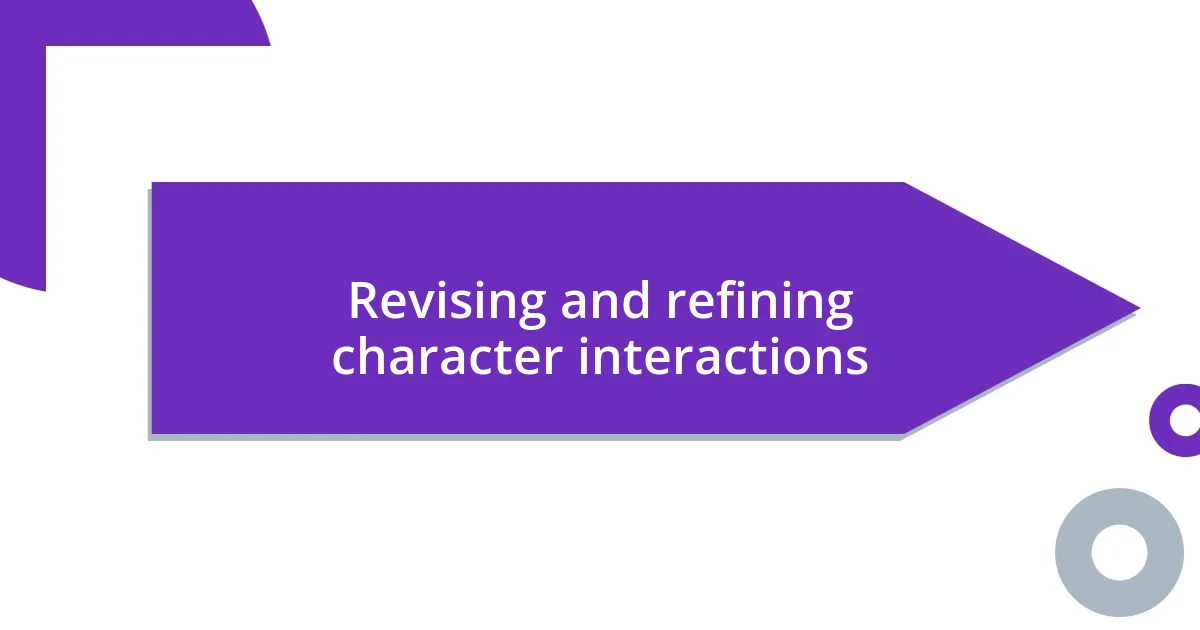
Revising and refining character interactions
Revising character interactions is often where the real magic happens in crafting relatable scenes. I once tackled a moment where two characters, long estranged, finally faced one another. After the initial draft, it became clear that their dialogue felt stiff and contrived. I went back, softening their words and adding hesitations, allowing their years of hurt to seep into their exchanges. The result was a raw, emotionally charged interaction that made my heart race—didn’t it feel like every unspoken word was a character in itself?
One of the lessons I’ve learned is the importance of body language in enhancing character interactions. In one scene, I initially wrote a conversation between a mentor and mentee where the words flowed easily. However, it felt flat. After revising, I added detailed gestures: the mentor crossing his arms, the mentee biting her lip in nervousness. Suddenly, the tension between them was palpable! Have you ever noticed how a slight shift in posture can alter the entire atmosphere of a scene?
As I reflect on my process, I realize that sometimes the most impactful revisions come from asking hard questions about character motivations. I remember reworking a confrontation where a character accused another of betrayal. Initially, the scene felt overly dramatic, lacking depth. After revising, I paused to consider what each character truly wanted. I focused on their underlying fears and desires, which revealed layers of complexity in their interaction. What drives your characters in those pivotal moments? Understanding this can breathe life into every exchange.





